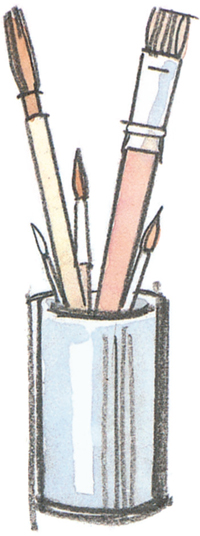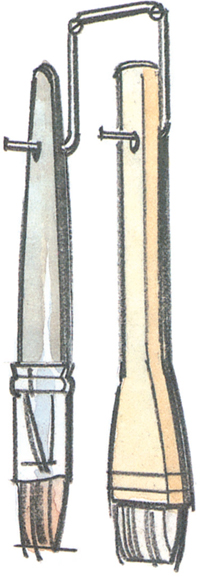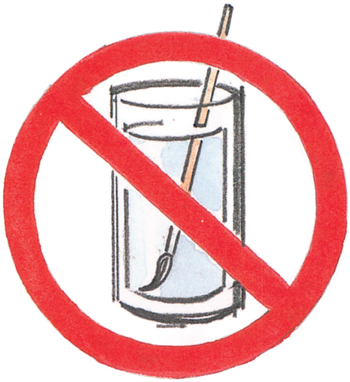
Brushes have either synthetic bristles, natural hairs or a combination of both. I can’t tell much difference between them except the price; natural hair brushes cost more.
An artist’s supply of brushes should include a range of shapes and sizes. Larger brushes hold more moisture and cover big areas, and smaller brushes work well for detailed work. I recommend the following collection of brushes for beginners.
A good round brush has fine, stiff hairs that come to a nice, straight point and spring back to their original shape.
Big bamboo brushes are inexpensive and hold lots of fluid. They work well for loose, spontaneous painting in big areas, but don’t expect to do detail work with them. Besides the large size, the coarse hairs don’t always make a point and may seem clumsy to handle.
Flat brushes look like regular housepainting brushes with wide, flat edges. A flat brush makes wide strokes and leaves clean edges. If you find a flat brush with a round handle, you can twirl the brush as you drag it across the paper to vary the thickness of the stroke.
Hake (pronounced “hockey”) brushes are flat, hold lots of fluid and are relatively inexpensive. Use a hake brush for really big washes.
To clean a brush, just swish it back and forth in water until the paint is released from the hairs or bristles. Gently dry it on a clean rag and lay it flat. Once you’re done painting, follow the instructions below. When considering quality and cost, don’t underestimate the importance of owning good brushes. Cheap brushes can save money but make for a frustrating painting experience.

When you’re done painting, clean your brushes and place them with the bristles or hairs up in a cup or can.

Drill a hole in the handles of large flat brushes, and hang them from nails, hooks or wires so the hairs or bristles hang down. If you use a nail, make sure the hole in the handle is wide enough to fit over the head of the nail. If you use a hook, make sure it’s deep enough to hold the handle.

Never stand a brush on its hairs, even in a jar of water. The hairs will bend permanently and ruin the brush’s point. Also, don’t squeeze the hairs to wring them dry or push down hard and scrub while painting. Brush hairs are delicate and the original shape can be bent easily. A good-quality brush can last for years if you care for it properly.

These are all the brushes you need to paint just about anything. In addition to the types of brushes mentioned previously, I also like quill mop brushes. They combine the precise qualities of round brushes with the capacity of bamboo brushes. The hairs are not springy, but they can make a nice point. These brushes require an investment, but they’re a lot of fun to paint with. Top to bottom, the brushes here include: no. 2 round, no. 6 round, no. 10 round, large bamboo brush, 1-inch (25mm) flat, 3-inch (76mm) hake, no. 8 quill mop and 2-inch (51mm) flat.